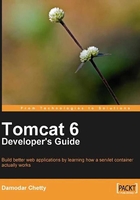
Conventions
In this book, you will find a number of styles of text that distinguish between different kinds of information. Here are some examples of these styles, and an explanation of their meaning.
Code words in text are shown as follows: "You will end up with a file named jdk-6u14-windows-i586.exe on your workstation."
A block of code will be set as follows:
[request-method] [/path/to/resource] [HTTP protocol version] [request-header=value]+ [blank-line to indicate the end of the request headers] [POST:request-payload]
When we wish to draw your attention to a particular part of a code block, the relevant lines or items will be shown in bold:
<?xml version="1.0" encoding="UTF-8"?>
<Context antiResourceLocking = "false" reloadable = "true" privileged = "false">
<ResourceLink name = "contactsTableCaption" global = "contactsCaption" type = "java.lang.String"/> <ResourceLink name = "jdbc/swengsolDB" global = "jdbc/swengsolDB" type = "javax.sql.DataSource"/>
</Context>
Any command-line input or output is written as follows:
mysql> help contents;
New terms and important words are shown in bold. Words that you see on the screen, in menus or dialog boxes for example, appear in our text like this: "Once the installation has completed, run the MySQL Server Instance Configuration Wizard".
Note
Tips and tricks appear like this.